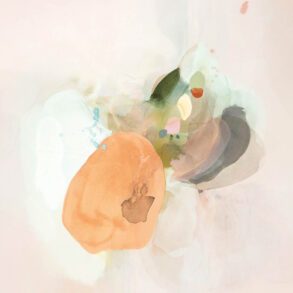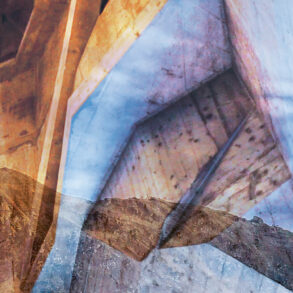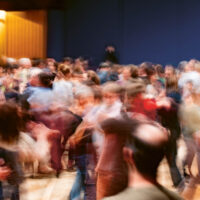In Jesus, the Logos itself has become a person.1
This book is not the first where Rudolf Steiner “became openly completely esoteric.”2 He’d already taken this step by writing on Goethe’s “Fairy Tale” in his Magazin für Literatur [Magazine for Literature] in 1899 (Goethe’s 150th birthday). But it is the first explicit presentation of the science of initiation. And thus, Rudolf Steiner set his course from an academic path to a spiritual one.
Stepping Back through Time
The book was in preparation for a long time. While still in Vienna, Rudolf Steiner shared his views on the nature of Christ and the reincarnation of the soul in a conversation with Wilhelm Neumann, the theologian, Cistercian priest, and later rector of the university, whom he’d met in the circle around the poet Marie Eugenie Delle Grazie.3 In his publications after this conversation, there are no explicit traces of these themes—until this book. We can understand this from Rudolf Steiner’s later statements that philosophical thinking can lead us to the Father-Ground of the world but not directly to Christ.4 Initially, he wrote philosophical texts, showing how we can think about the spirit, how we can think about questions of truth and freedom—with the earthly brain. Gradually, along this path, we can find our way into the spiritual world. But henceforth, spiritual remembering becomes more important than philosophical logical reasoning. The esoteric goes back to its origin; in a sense, it walks backward through time to the source of spiritual life.
Thus, we have Rudolf Steiner’s first three purely philosophical writings (CW 2, 3, 4), then a writing on Nietzsche, whom he’d just met (CW 5), and next, the book summarizing the spirit of Goethe (a spiritual biography, not a life history in the usual sense) (CW 6), as he couldn’t meet Goethe upon the Earth. At the turn of the century, he wrote Welt- und Lebensanschauungen im neunzehnten Jahrhundert [Worldviews and life views in the nineteenth century] (Kant and Goethe to Darwin and Haeckel), about the age of Goethe and its consequences (later expanded to CW 18). Then, we have a presentation on the Middle Ages preceding this time, leading into the beginning of modern times in Mystics… (CW 7). Only then do we move on to antiquity and the early Middle Ages with Christianity as Mystical Fact (CW 8). So, a path backward through time. Let’s follow a few threads.
The Ground of the World and Freedom
It’s already stated in Goethe’s Theory of Knowledge (CW 2): “The ground of the world has entirely poured itself out into the world; it has not withdrawn from the world to direct it from outside, it drives it from within…. The highest form in which it comes forth within the reality of ordinary life is thinking and with this the human personality.”5 In that the human being thinks and has spirit, he can raise himself to freedom. The human being initially experiences the spirit only as thought. It is precisely because of this that we are free; because we ourselves think, and the ground of the world leaves the human being free to find the understanding for themselves. We humans find (as at the end of the Philosophy of Freedom) the unified ground of the world, the idea as communal divine life in its reality…. The world is God.6 Philosophy reaches the Father-Ground.
The Christ is not found here directly. This requires the fruit one has acquired through this philosophical training, “the intuition… that the human being lives within a true spiritual world. The pursuit of this book is to justify knowledge of the spiritual realm before entrance into spiritual experience.”7 The personality is spiritual in nature (this is why the human sciences should be “free sciences,” as mentioned in Goethe’s Theory of Knowledge).8 The philosopher (and anyone who thinks seriously) is unconsciously clairvoyant, because the idea is already spiritual. However, one must free oneself from the effects of the brain to consciously experience the spiritual light—precisely as “unmanifest, unrevealed light”—which does not shine in the light of the senses.9
Simply put, the further experience of the spirit requires a surrender of the earthly personality. This is where we cross over the threshold and arrive at Goethe’s “Fairy Tale.” There, the central act is the sacrifice of the serpent: “What a mystic like Jakob Böhme expressed with the words, ‘Death is the root of all life,’ Goethe expressed with the sacrifice of the serpent.”10 Historically speaking, mysticism is this overcoming of the personal ‘I’-consciousness. Rudolf Steiner’s book Mystics describes the various ways Meister Eckhart, Johannes Tauler, Jakob Böhme, Angelus Silesius, and others experienced this overcoming of self. The problems of medieval scholasticism and Christian dogmatics are also sharply outlined. God is not only a cognitive image in the soul, rather God lives in the soul itself. One’s own inner life is itself the life of God. Dogmatic theology (Augustine), which indelibly separated God and humanity through the Fall, prevented the mystic from recognizing this.
We note that Rudolf Steiner avoids dealing with Thomas Aquinas explicitly here. But he includes quotations from Karl Werner and Otto Willmann that indicate he is in the process of clarifying his own thinking about his previous incarnation in the time of scholasticism. The theme of this book and the self-knowledge of individuality go hand in hand here.
The Recognition of the Christ Impulse
Whoever finds their way beyond the boundaries of the body into the flooding of suprasensible light will have difficulty maintaining their ‘I’-consciousness. We learn that this ability to maintain consciousness depends upon the relationship we have formed—in our sensory consciousness—with Christ and His deed on Golgotha.11 In the Christian Middle Ages, it was believed that Christ brought about the resurrection of the believing soul and actually worked in the substratum of the soul, though it was not yet understood in full consciousness. The task that Rudolf Steiner set himself in Christianity as Mystical Fact was to grasp the deeds of Christ as the awakener of Lazarus—to understand these deeds both within the course of history and as they stand outside of time, eternally.
Any impartial observer can see a great difference between the pre-Christian and the Christian Mysteries. The ancient Mystery was the rebirth in the human soul of the divine hidden in nature. The lower nature in the human being had first to be “laid in the grave.” The various Mysteries speak of this differently in different times and different lands, yet they remain united in the fact that humans needed to step outside themselves to allow the divine to arise. With Christ, we now have the inverse: initiation occurs in the baptism in the Jordan as an indwelling of the Christ being in Jesus—Word become flesh. Through death and resurrection, when he unveils himself to his community, it becomes clear that the spirit endures in the earthly: “In Jesus, the Logos itself has become a person.” By fully overcoming the earthly personality through the Logos, the contrast between the soul and the spirit is lifted. Comparing this with the ancient Mysteries, we can say: in Jesus, the ancient tradition of the Mysteries became a personality. The Father became fully active in the soul. In Jesus, Christ became his ‘I.’ This deification must “appear to human beings as the greatest ideal to which they should unite themselves more and more through their repeated lives in the future.”12 Perhaps, this was all expressed to Father Neumann already back in Vienna.
Personal—Supra-Personal
In the book, we find depictions of the ancient Mysteries, the Gospels, and the Apocalypse, as well as the Mysteries behind Greek philosophy, from Heraclitus to Plato and the Neoplatonists. Concerning Aristotle, the originator of Western scientific philosophy, which will work with pure thought, Rudolf Steiner is silent. But once he’d clarified the position of Christ as the initiator of future cultural epochs, he was then able to let philosophy pass over to anthroposophy, which reckons with the Christ impulse in the human ‘I’; and then, he was able to become a spiritual teacher for a new schooling path.
Event
Rudolf Steiner lesen und verstehen [Reading and understanding Rudolf Steiner]: Conference of the Section for the Literary Arts and Humanities at the Goetheanum, May 1–4, 2025, with Andre Bartoniczek, Anna-Katharina Dehmelt, Ariane Eichenberg, Volker Frankfurt, Eckart Förster, Christiane Haid, Jaap Sijmons, and Renatus Ziegler.
More Section for the Literary Arts and Humanities
Translation Joshua Kelberman
Footnotes
- Rudolf Steiner, Christianity as Mystical Fact and the Mysteries of Antiquity, CW 8 (Tiburon, CA: Chadwick Library Press, 2021), in Chapter 6, “The Mystery Wisdom of Egypt.”
- Rudolf Steiner, Autobiography: Chapters in the Course of My Life, 1861–1907, CW 28 (Great Barrington, MA: SteinerBooks, 2006). The quote refers to his lecture “Goethe’s Secret Revelation,” given to the circle around Count and Countess Brockdorff. The essay of the same name is from the “forecourt of esotericism” and is still “not very esoteric” (ibid.)
- See footnote 2.
- Rudolf Steiner, Man in the Light of Occultism, Theosophy, and Philosophy, CW 137 (Blauvelt, NY: Garber Communications, 1989), lecture in Oslo (Christiania) on June 5, 1912.
- Rudolf Steiner, Goethe’s Theory of Knowledge with Special Reference to Schiller, CW 2 (Tiburon, CA: Chadwick Library Press, 2021), Chapter 19, “Human Freedom.”
- Rudolf Steiner, The Philosophy of Spiritual Activity. Fundamental Features of a Modern Worldview: Results of Soul Observation According to the Natural-scientific Method, CW 4 (Tiburon, CA: Chadwick Library Press, 2020); also known as The Philosophy of Freedom; see chapter “The Consequences of Monism.”
- See footnote 6, chapter “Preface to the revised edition (1918).”
- See footnote 5, chapter “The Spiritual Sciences. Introduction: Spirit and Nature.”
- See footnote 4, lecture on June 4, 1912.
- Rudolf Steiner, “Goethe’s Secret Revelation,” in Goethe’s Secret Revelation and The Riddle of Faust (London: Percy Lund Humphries & Co., 1933).
- See footnote 4, lecture on June 10, 1912; and Rudolf Steiner, Cosmology, Religion, and Philosophy, CW 25 (London: Rudolf Steiner Publishing, 1955), chs. 7 and 8; Philosophy, Cosmology & Religion, CW 215 (Spring Valley, NY: Anthroposophic Press, 1984), lectures on Sept. 12 and 13, 1922.
- See footnote 1, Chapter 11, “On the Essence of Christianity.”









